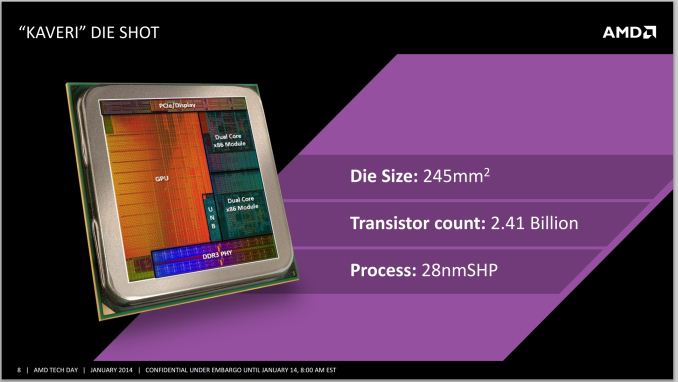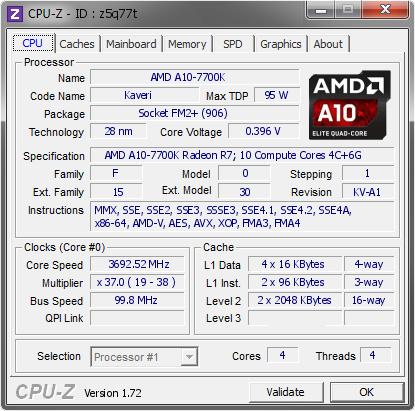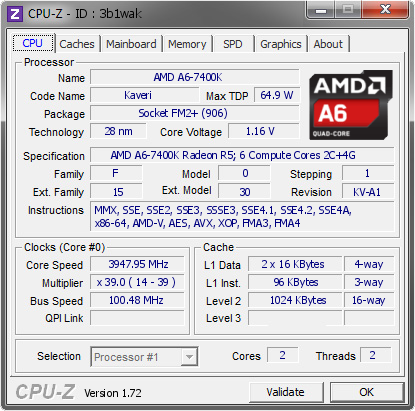The AMD A10-7700K and AMD A6-7400K CPU Mini-Review
by Ian Cutress on May 27, 2015 9:00 AM ESTAMD A10-7700K and AMD A6-7400K Conclusion
I started this mini-review stating that the question of the number of processors that both Intel and AMD produce all seem to differ by 100 MHz and $7, and that I had received questions as to why this is the case. Ultimately a lot of recommendations for computer components start to revolve around ‘Well for $10 more, you could get this’, and at some point you are considering something that costs $50 more. There has to be a point where you stop, especially if an IT department or system builder wants to go through and develop 200+ machines in a month.
Intel and AMD currently have different approaches to this. Intel likes to launch a big part of its stack all at once. Sometimes it will launch individual units outside this, or it will start a new line-up with one or two units then introduce the bulk later. With Haswell for example, on the socketed CPU space, we have 50 different CPUs varying in price, power, frequency, core count, threading and integrated graphics. Imagine the poor reviewer that has to test them all (insert here that I’d love to test them to get all the data, if I had time and could source them)!
AMD’s approach to Kaveri is to dribble rather than gush. Rather than overload the user base (both end-users and commercial) with a large haystack of parts, they launched two or three SKUs on day one, then one or two every 6-12 weeks since. This has some benefits, namely the improvement of the production process over time, the repeated opportunities to market new products and the opportunity to re-educate potential clients through the media. The downside of this strategy is one similar to starting with Swiss cheese and then filling in the holes – if a client wants a SKU with particular characteristics but the company does not have it, then they will go look for something else and take their money with them. It’s a method that acts as a double edged sword.
As AnandTech’s CPU editor, I get to play with a lot more SKUs than most. This means both the big shiny halo products, such as the 8-core goliaths, but also some of the higher volume dual core stuff which is more in line with a budget PC or mass PC build. With AMD’s strategy, as they have fewer processors overall, our coverage can be a little more complete than the others. AMD sampled us both the A10-7700K and the A6-7400K for this purpose, and we hope to work closely with them for future launches and get the best comparison list of their product stack.
Back to the SKUs tested for this mini-review, we can tell that the A10-7700K keeps up with the other A10 parts in our CPU testing, but as it has two fewer compute units in the integrated graphics it can lag behind a little and is more in line with the A8 processors in that regard, essentially making it more of a hybrid part. The A6-7400K fits into that budget CPU line at $64, and the results show this in both our CPU and GPU testing. The single module performs well enough in single threaded environments, but doesn’t have enough legs for the big tasks and can be swamped easily. Despite having two threads, the Bulldozer based design still has single-threaded like behavior in some tests. That being said, the graphics tests are a mixed bag. For titles that can use more threads, I can’t help but feel that it is a little held back, even at 256 SPs. For other titles, it performs on par with other processors almost double its price. Dual Graphics mode unfortunately was not possible with the A6, and it was also noticeable that some games (Shadows of Mordor in particular) took longer to load with only one module.
To say AMD’s APUs are like marmite (you either love them or hate them) is to gloss over a more complex issue. AMD’s design has its plus points and its negative points, a fact that AMD marketing knows when I speak to them. Nevertheless, they have to focus on the plus points, which include gaming at equivalent price points, DX12 support, OpenCL performance and moving forward with HSA. Using the right tool for the right job should now be considered a cliché, but it rings true when it comes to technology and more so than ever when innovative methods are continually being fashioned. Based on AMD’s Financial Analyst Day and their recent exposure into HBM (I highly suggest reading Ryan’s awesome writeup on it), I can safely say that I want to see an APU with HBM in the future. Despite the inevitability that AMD already know that people want one, I told them anyway. We will have to wait and see.














105 Comments
View All Comments
testbug00 - Wednesday, May 27, 2015 - link
godavari appears to just be Kaveri 2.0.Like Richland was to Trinity.
Clockspeed bumpbs, perhaps power reduction. No IPC increases.
MrSpadge - Wednesday, May 27, 2015 - link
I wouldn't call it 2.0 if it's just the same chips in different configurations (we should see soon if this is true). It's something they could mostly have done over a year ago.testbug00 - Wednesday, May 27, 2015 - link
It probably is a major stepping revision. Hence, it is a slightly different voltage/etc characteristics, but the same core layout.Edens_Remorse - Wednesday, May 27, 2015 - link
The improvement in stock cooling alone warrants a review. Athlon x4 860k/870k is an absolute gem for gaming. Too bad reviewers give us this year old b.s. knowing full well what is coming tomorrow.just4U - Wednesday, May 27, 2015 - link
I am perfectly ok with Ian reviewing these and getting them into the bench. The A6 part of the review was very welcome and it's nice to know that the A10 is actually more on par with the A8 which makes choices a little easier.A 870 or 860 review with the new coolers though.. hmmm ... "YES!" please do that if you can Ian. I've built a few systems with the 860 and it's crappy cooler.. which does the trick I suppose considering it doesn't run as hot as some of the A8/10s.
Alexvrb - Thursday, May 28, 2015 - link
The more chips that are in Bench the better.As far as coolers go, I will applaud improved coolers but on the other hand... aftermarket cooling is almost a must if you overclock regardless. Doesn't have to be extreme, there's some good budget heatsinks out there.
eanazag - Wednesday, May 27, 2015 - link
When the 7850K was at $178; it was too close to the i5 cores that it made no sense. It is much more competitive at $138. I'd really like to see it at $125.AMD makes sense on IGP only gaming at 720P. Or old games at 1080P.
Refuge - Wednesday, May 27, 2015 - link
Or just lower quality Textures at 1080p (Which makes the bad textures look even worse btw).Its that damn slow memory that hamstrings those iGPU's
Edens_Remorse - Wednesday, May 27, 2015 - link
You can buy the 7850k online today for $125. Cheaper if you live near a Microcenter($119). This "review" is pure b.s.mdriftmeyer - Wednesday, May 27, 2015 - link
Right, because $13 dollars is passed your price range.